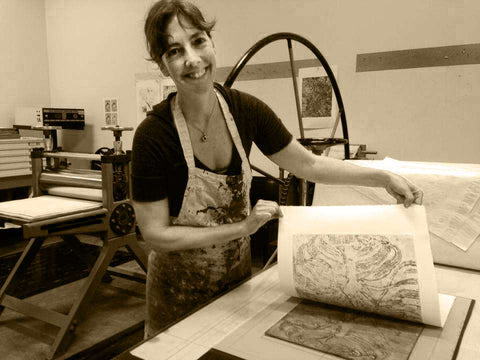About

Bend, Oregon artist Amy Royce explores communication, body language and non-verbal expression, engaging the senses and emotions through many mediums. Royce received her BA in Art with a painting emphasis from Humboldt State University in Arcata, California. Her work was selected by Judy Chicago and awarded the Artistic Merit Prize for the 20th Anniversary Women’s Works Exhibit in Illinois. More recently, she received a scholarship to study art at Anderson Ranch Arts Center.
Working with Metals and Stones
Amy then returned full circle to jewelry making.
"I've been making beadwork jewelry since the 1990's and always wanted to learn metalsmithing. I've been slowing adding tools, and honing my skills in soldering and stone-setting. It's gratifying in a similar way to painting, because it satisfies my inner sculptor, but challenges me to spend time on design and precision while learning new skills and ways of thinking."
About Encaustic
Painting in Encaustic has been a parallel path since the '90's when Amy saw a Jasper Johns painting from the Abstract Expressionist movement and turned her focus from oil painting to contemporary uses of the ancient medium. Beeswax is melted with resin and pigment to make the paint, and it is applied hot with a variety of techniques and tools. Each layer of wax must be fused with heat to the layer beneath it. The method of painting with wax came from ancient Greece where shipbuilders painted the hulls of their ships to seal, protect and decorate the surfaces. This led artists to use encaustic for easel painting and decoration of clay and marble sculptures, and on to the ancient Fayum portraits of Egyptian mummy casings. The medium was lost in obscurity from the seventh century until the twentieth century where artists such as Diego Rivera, Arthur Dove, Karl Zerbe and finally Jasper Johns began to revive it. More and more contemporary painters and sculptors are experimenting with encaustic in a range of styles and techniques due to increasingly available resources and materials. The possibilities for luminous color, variety of texture, and depth are limitless.
"Encaustic is a very physical, sculptural medium. The viscosity and heat of it move me. At times I attack the surface, other times the warm malleability requires a deft, delicate touch. To create my artwork, I pour and paint encaustic wax including dripped, carved and etched lines and textures. These are filled with either more encaustic or oil bar colors, building geologically to embody a relief or sometimes 3D form. A hot iron or torch is used to fuse each layer. To build depth and surface, the translucent layers are progressively carved, painted and partly scraped away to selectively reveal the texture, form and colors beneath."
Caring for an encaustic painting is simple.
Like any fine art, encaustics should be kept out of direct sunlight. Corners and edges should be protected from dings. Never store the work at extreme temperatures. Dust gently with a soft cloth and handle with care. The unvarnished surface is very stable and continues to cure and harden over time.
Printmaking
Printmaking, with it's multiple approaches using both reductive and additive techniques, also informs Amy's process for painting and metalsmithing. Original hand-pulled prints are printed with tools as simple as a wooden spoon rubbed on the back of the paper over the plate; sometimes a traditional printing press is used, or sometimes a…Steamroller!
"I love this eclectic medium and use all kinds of methods to create the plate: from letterpress, solarplate, intaglio and relief printing, to Monotypes or Encaustic and traditional collagraph plates."
Each one-of-a-kind work on paper was printed in studio or at the former Atelier 6000 in Bend, OR.